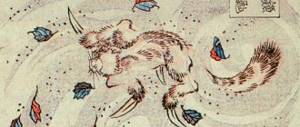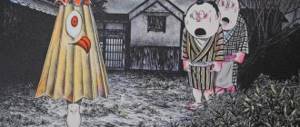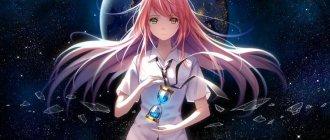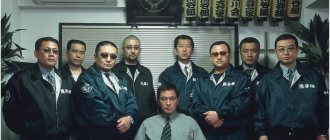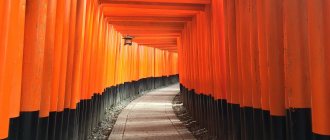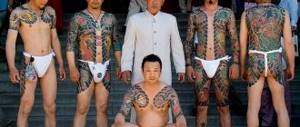Ask the first person you meet: “What Japanese monsters do you know?” Most of the time you will hear: “Godzilla, Pikachu and Tamagotchi.” This is still a good result, because Russian fairy-tale creatures, through the eyes of the average Japanese, are something between a matryoshka, Cheburashka and a drunken polar bear. But Russian and Japanese cultures can boast of such ancient menageries that some American Paul Bunyan never even dreamed of. “World of Fantasy” has already taken a walk along the unknown paths of Slavic myths, studying the traces of unprecedented animals. Today we will travel to the opposite side of the planet and see what bizarre creatures live under the rays of the rising sun.
You can't understand Japanese folklore without a bottle of sake. It was formed thanks to the centuries-long “collaboration” of Chinese Buddhism and national Shintoism - a unique process during which the principles of one religion were complemented by the commandments of the other.
Such syncretism gave rise to an amazing interweaving of myths: Buddhist deities preached Shintoism, and primitive Shinto magic did not at all contradict the complex Buddhist picture of the world. To understand the uniqueness of this phenomenon, it is enough to imagine the idol of Perun in the altar of a modern Orthodox church.
The peculiarities of the national worldview, coupled with Buddhist mysticism and the remnants of primitive beliefs, made Japanese monsters completely different from their Western “colleagues.” Ghosts settled next to people and animals under the red sun - something like fairies in their classical European understanding, but unlike each other and successfully replacing all the chimeras invented by humanity.
Hiyakki Yako, the annual ghost parade. It is better not to go outside at this time.
Japanese ghosts are not restless souls of the dead or clots of protoplasm from parallel worlds. The concept of obake, derived from the verb bakeru - to transform, to transform, is most often applied to them. Obake may well be creatures of flesh and blood. The main thing about them is that these “ghosts” turn from one thing to another, changing symbols and meanings, and also disrupting the natural course of things.
Yokai and Samurai (artist Aotoshi Matsui).
Supernatural horror in Japanese culture is focused not on some otherworldly objects, but on the irrational modification of familiar forms.
A skeleton in a white shroud, glowing eyes in the dark and an eerie howl in a cemetery will frighten a Japanese much less than a crumpled paper lantern or strange television interference. The basis for such fears is a simple (if not primitive) picture of the world. Similar “horror stories” about a black hand or a white sheet were once in great demand in the Ogonyok magazine. From obake, an independent class of ghosts is sometimes distinguished - youkai (Japanese folklore terminology is very confusing and there is simply no single classification). Their main feature is their unusual appearance (one eye, long neck, etc.). Yokai resemble Russian brownies or goblins. These creatures live in a certain area and do not seek to meet humans. Yokai can be either friendly or malicious. They are associated with fire and the northeast. In winter, encounters with evil spirits are rare.
In the vastness of Japan, you can also find quite normal ghosts of yurei - souls deprived of peace. Shintoism teaches that after death the soul waits for the necessary rituals to be performed on the body, after which it safely departs for the next world. The deceased spirit can meet living relatives once a year - in July, during the Bon holiday. But if a person dies a violent death, commits suicide, or if the rituals over his body are performed incorrectly, the soul turns into a yurei and gains the opportunity to penetrate the world of the living. Yurei can be found at the place of his death, but you should not strive for this, because the main occupation of the restless ghosts is revenge.
Most yurei are love-stricken women. Initially, the Japanese believed that their appearance was indistinguishable from their lifetime, but soon traditions began to change, and instead of a face, the ghostly lady could have a huge eye.
Today the appearance of yurei is standardized. They are dressed in a white funeral kimono. The hair is jet black, long (supposed to grow after death) and flowing over the face. The arms hang helplessly down, instead of legs there is emptiness (in the Kabuki theater actors are suspended on ropes), and otherworldly lights curl next to the ghost.
Sadako ("The Ring")
Kayako ("Malice")
The most famous yurei in the West are Sadako (“Ring”) and Kayako (“Anger”).
Kama-itachi
Kama-itachi.
Illustration from Kyoka Hyaku-monogatari, 1853. Image: Wikimedia Commons Kama-itachi is a Japanese weasel-shaped yōkai (evil spirit). Literal translation of MD Foster. The Book of Yokai: Mysterious Creatures of Japanese Folklore - "weasel with sickles." Tales of kama-itachi are popular in the Koshinetsu region of Japan. These creatures always appear in threes - it is believed that they are triplets. They are engaged in cutting off people's lower limbs. The sequence of actions is as follows: the first weasel knocks down the victim, the second removes the legs with sickles that grow on it instead of claws, and the third stops the bleeding and sews up the wounds.
But the most amazing thing is that the trio of kama-itachi, transported in the form of a dust devil, moves at about the same speed as the Flash in the DC Universe.
And it takes them less than a second to do the dirty deed.
Kama-itachi manage to carry out the amputation so that the victim does not feel any pain at all. It’s very nice that caring weasels take the time to patch up the injured person before flying away and taking his legs with them.
Moral: Don't go out during a dust storm.
Konaki-diji
Konaki-diji.
Illustration from folklorist Kunio Yanagita's book Yōkai Dangi, 1956. Image: Public Domain Konaki-diji is a supernatural creature by T. Francis-Cheung. The Element Encyclopedia of the Psychic World: The Ultimate A-Z of Spirits, Mysteries and the Paranormal, which looks like a small child or even a baby, but with the face of an old man. True, he is always prudently positioned in such a way that his face can be seen only when it is too late to do something.
Konaki-diji sits on the side of some mountain path in deserted places and roars.
A random traveler or traveler, seeing an abandoned child, picks him up in his arms to console him. As soon as the konaki-diji is lifted off the ground, it suddenly acquires additional mass (plus 2-3 centners) and flattens the kind-hearted traveler.
Women especially suffer from this youkai. Firstly, they cannot pass by a sobbing baby. Secondly, the average Japanese woman has little chance of surviving after a konaki-diji falls on her. But a particularly strong samurai has a chance to survive, and in this case the yokai will reward him for his endurance.
Moral: Stay away from small children.
Osiroi-baba
Osiroi-baba.
Illustration from the book Konjaku Hyakki Shūi, 1780. Image: Wikimedia Commons The Ghost of T. Francis-Cheung. The Element Encyclopedia of the Psychic World: The Ultimate A-z of Spirits, Mysteries and the Paranormal in the form of a terrible, disgusting hunchbacked old woman. Her face is roughly covered in powder, and she holds a bottle of sake in her hand. Osiroi-baba walks the streets with an umbrella and a stick and looks out for beautiful young women.
When she finds one, she immediately runs up to her and in a soulful voice begins to convince her to buy some powder from her.
The naive girl agrees to take a sample, smears herself with powder, and her face falls off.
Moral: if you are a young beautiful woman and an intrusive cosmetics salesman approaches you, walk away silently.
Ittan-momen
Ittan-momen.
Drawing by Tosa Mitsunobi, 16th century. Image: Wikimedia Commons The Japanese have a belief that if any forgotten object lies for a long time (for example, 100 years), it will gain consciousness and turn into a youkai - tsukumogami. Ittan-momen is a sheet that has become intelligent.
This wild but cute ghost without a motor loves to swoop down on passers-by at night and strangle them.
There is a legend about L. Bush. Asian Horror Encyclopedia: Asian Horror Culture in Literature, Manga and Folklore, that this damned levitating sheet once almost strangled a samurai. But he managed to take out the wakizashi blade and cut the ghost. Ittan-momen disappeared, leaving bloody marks on the warrior’s hands.
Other legends mention that ittan-momen can befriend a person and even serve him if he manages to earn the trust of a ghost. True, no one knows what a flying piece of fabric can do for you.
This is because no one has yet managed to make friends with him, and in fairy tales this moment is tactfully avoided. So, if you find yourself in Japan and encounter an ittan-momen, you will have to test this theory yourself.
Moral: Don't hoard old things or they will try to kill you.
Japanese demonology
28 Jul
Home › Demonology and History of the Worlds › Japanese demonology
- EdenV
- 0
- 1 comment
In Japanese demonology, there are two large categories of demonic creatures - youkai and yurei . Yokai, defined as ghosts or ghosts , have an ambiguous meaning: the word is written in two hieroglyphs, one meaning “magical, wonderful” and the other meaning “mystery, something strange, ghost”. If we talk about their appearance, they are quite numerous and diverse in their appearance, habits, functions and habitat. The main feature is an unusual appearance (one eye, long neck, etc.). Yokai resemble Russian brownies or goblins . These creatures live in a certain area and do not seek to meet humans. Yokai can be either friendly or malicious. They are associated with fire and the northeast. In winter, encounters with evil spirits are rare.
Yurei are also ghosts and ghosts, but the word is written in hieroglyphs for “other world” and “soul”. Youkai and yurei differ from each other in that the former are completely material and anthropomorphic, despite the fact that their appearance is often unusual. It is in this unusualness that their special appeal lies.
So, for example, the youkai that lives on the side of the road has only one eye, which is why it is called itime kozo - “one-eyed monk”, and the rokurokubi - “horror monster with a long neck” - the neck is really so long that it gives the impression as if the head is held on by a long cord and exists almost independently of the body. All youkai love to live in strictly defined places; they are tied to their “area of activity.” Some live in rivers and never move to the sea, others wait for belated travelers on a mountain path and never approach human habitation. It is clear that youkai do not seek out a meeting with a person on purpose.
They live their own lives, into which a person suddenly, accidentally invades, and it turns out that the person himself came to the youkai, and not they to him. That is why meeting with the unknown in Japanese folklore is random, unplanned. Youkai are children of twilight, the time of their appearance is usually associated with the fading of the day, which is why even the hours from dusk to darkness are usually called “ ouma-ga doki ” (“time of meeting with the demon”). The bringing of yurei has a different purpose, since the origin is different: it is to appear before a living person and come into contact with him.
According to the canons of Shintoism , after death, a person’s soul waits for a moment when no one is around, and no one mourns the deceased, and only then leaves the body. The soul of those who died a natural death becomes the spirit of their ancestors, while those who died a violent death become yurei. An interesting fact is that, despite the gender of the person who died a violent death, yurei always have a female appearance. They come into the house on a dark night, which makes their outlines blurry and unclear. It is believed that their upper body is anthropomorphic, and closer to their legs, their silhouette becomes as if shrouded in haze, ghostly, which creates the impression that they are floating through the air, leaving behind only a thin stream of smoke.
Legs serve all creatures to contact the earth, connect them to it, so the absence of legs in a sense symbolizes the absence of such a connection. This feature of the Japanese ghost is similar to the Western ghost's ability to float above the ground without using the legs it theoretically possesses. Japanese ghosts do not have legs because, by connecting people to the soil, the legs emphasize which part is above and which is below, i.e. there is a demonstration of the right and wrong way. As a consequence, to be without legs is to be deprived of this standard.
In addition, this feature of Japanese ghosts also determines the time of their appearance. Thus, ghosts come at night not only because they like the dark, but also because in sleep people's feet are located at the same level as their heads. Ghosts are able to change this order.
At funerals, Japanese corpses were buried in a sitting position (although cremation is more common today) so that they could enter the next life in the correct position, with the head (mind) up. It is noteworthy that Japanese ghosts are not tied to any specific location, like European ghosts - they can follow their victim everywhere. Most often, yurei like to live in abandoned houses, old temples, dilapidated mountain huts, where they await the unlucky traveler.
From youkai , who are quite often simple-minded and gullible, yurei quite often appear as truly terrifying characters, this also applies to their appearance: such a ghost may have a translucent ball instead of a face with one eye on its chin, or even have no eyes at all , eyes (or even two or three eyes) can even be located on the elbow.
Most yurei are women who have suffered from love. Initially, the Japanese believed that their appearance was indistinguishable from lifelong, but soon traditions began to change, and instead of a face, the ghostly lady could have a huge eye. Today the appearance of yurei is standardized. They are dressed in a white funeral kimono. The hair is jet black, long (supposed to grow after death) and flowing over the face. The arms hang helplessly down, instead of legs there is emptiness (in the Kabuki theater actors are suspended on ropes), and otherworldly lights curl next to the ghost.
It should be noted that yurei is an embodied goal, i.e. he won't give up until he gets his way. The goal, in addition to all of the above, is also to appear before a person living in vain and, if possible, frighten him so that he immediately transfers to the yurei class.
As mentioned above, many of the yurei are children of violence, that is, the ghosts of women who suffered terribly during life from the vagaries of love: whose strong feelings of jealousy, grief, regret or anger at the time of death led them to seek revenge on anyone who turned out to be the cause of their suffering. Male yurei are less common and less likely to seek revenge. Although, sometimes, in films, we can see the opposite (“The Grudge”).
Most often, a male yurei is a warrior who has been killed in battle and therefore has no personal grievance (since death was part of his trade), but cannot separate himself from the historical events in which he participated. Such Yurei of this type are usually at first glance indistinguishable from a real person: he wanders around ancient battlefields or in the vicinity of a temple, waiting for a passing traveler who might listen to his story about the events of days gone by. In recounting these events, he usually seeks to regain his reputation and restore his good name. Such ghosts reveal the secrets of history and calm down only when the truth becomes known.
Initially, it was believed that all yurei in a ghostly state were no different from the living state. At the end of the 17th century, when kwaidan became more and more popular in literature and theater, yurei began to acquire some characteristics that characterize them to this day. Obviously, such a change in the idea of the appearance of yurei occurred in order to facilitate the distinction between yurei in art and on stage from the real
an ordinary living character.
There is also such a category of Japanese ghosts as o-bake, they are similar to yurei, but differ in that the first are the souls of the dead, who did not realize that they had died, and therefore appear at the place of death.
Most of the characteristics of yurei originate from the burial rituals of the Edo period. So, for example, they appear in white (this was the color of the clothes in which people were buried at that time), or in a white katabira (a simple, unlined kimono), or in a kyokatabira (a white katabira on which Buddhist sutras are inscribed). Yurei also appear with a white triangle of paper or cloth on the forehead, usually tied around the head with a thread, called a hitai-kakushi (literally "forehead covering"). It was originally believed to protect the recently deceased from evil spirits, but eventually became simply part of the ritual vestment at Buddhist funerals.
Shintoism teaches that after death the soul waits for the necessary rituals to be performed on the body, after which it safely departs for the next world. The deceased spirit can meet living relatives once a year - in July, during the Bon holiday.
A Brief Bestiary of Japanese Demonology
Abumi-guchi : When a warrior died in battle, the stirrups from his horse were sometimes left on the battlefield. There they came to life, turning into a strange furry creature, forever searching for its missing owner.
Abura-akago: the souls of merchants who, during their lifetime, sold oil stolen from lamps at roadside shrines. They fly into the room like clots of fire and turn into a baby who sucks all the oil out of the lamp, after which they fly away.
Azuki-arai : a little old man or woman washing beans in mountain streams. Sings threatening songs (“Should I wash beans or eat someone?”), but is actually shy and harmless.
Aka-name: “dirt licker” appears in those baths that have not been cleaned for a long time. As its name suggests, it feeds on unsanitary conditions. Its appearance quickly instills in people the habit of cleaning up after themselves in washrooms. His relative, the long-legged tenyo-name, licks the dirty ceilings.
Ama-no-zako: born from the rage of the thunder god Susanoo. Ugly, has strong teeth that bite through steel. Can quickly fly over long distances.
Ama-no-zaku: An ancient demon of stubbornness and vice. He reads people's thoughts, makes them act in such a way that their plans are carried out exactly the other way around. In one of the fairy tales, he ate a princess, put on her skin and tried to get married in this form, but was exposed and killed.
Ame-furi-kozo: spirit of rain. Appears in the form of a child covered with an old umbrella and carrying a paper lantern in his hands. Loves to splash in puddles. Harmless.
Ami-kiri: There are a lot of mosquitoes and ghosts in Japan in the summer. One of them, looking like a cross between a bird, a snake and a lobster, loves to tear up mosquito nets, as well as fishing gear and drying clothes.
Ao-andon: In the Edo period, people would often gather in a room, light a large blue lantern with a hundred candles, and start telling each other scary stories. At the end of each of them, one candle was extinguished. After the hundredth story, the light went out completely and ao-andon appeared.
Ao-bozu: a short cyclops who lives in young wheat and drags children there.
Ao-niobo: A cannibal who lives in the ruins of the imperial palace. During her lifetime she was a maid of honor. Distinguished by black teeth and shaved eyebrows.
Ao-sagi-bi: analogue of the Firebird: a heron with fiery eyes and white luminous feathers.
Asi-magari: a ghostly raccoon dog. At night, it wraps its tail around the legs of travelers. Her fur feels like raw cotton.
Ayakashi: A sea serpent about two kilometers long. Sometimes it floats over boats, forming an arch with its body. This can last for several days, during which the people in the boat are busy scooping out the mucus that oozes profusely from the monster.
Baku: Chinese chimera with the body of a bear, the trunk of an elephant, the eyes of a rhinoceros, the tail of a cow, the paws of a tiger and a spotted skin. Feeds on dreams. If you see a bad dream, you should call on the tank, and it will absorb it along with all the foreshadowed troubles.
Bake-zori: An old sandalwood that has not been well cared for. Runs around the house and sings stupid songs.
Bake-kujira: a whale skeleton accompanied by strange fish and ominous birds. Invulnerable to harpoons.
Bake-neko : If a cat is fed in the same place for 13 years, it will turn into a bloodthirsty werewolf. Bake-neko can be so huge that it will not fit into the house, but instead will rummage around with its paws, looking for people like mice in a hole. Sometimes a werewolf takes on the appearance of a human. There is a well-known story about how a cat disappeared in one house.
At the same time, the behavior of the mother of the family began to change: she avoided people and ate, closing herself in the room. When the household decided to spy on her, they discovered a creepy humanoid monster. The owner of the house killed him, and a day later she again turned into the missing cat. Under the tatami on the floor, the mother's bones were found, gnawed clean. Cats in Japan were associated with death. Therefore, people were very suspicious of cats of deceased owners. These animals could become kasa, stealing corpses, or two-tailed nekomata, playing with dead bodies as dolls.
To avoid such a disaster, kittens need to have their tails docked (so that they do not fork), and the deceased's cat should be securely locked up. The image of a cat was not always gloomy. Porcelain maneki-neko figurines bring success to store owners. During a thunderstorm, the cat led the rich man away from the tree that was about to be struck by lightning, after which he began to patronize the temple. One geisha's cat did not allow her owner into the restroom where the snake was hiding. Finally, cats often took the form of people and became the wives of single men or the children of childless couples.
Basan: overgrown rooster. At night he walks the streets and makes a strange noise - something like “bass-bass”. People look out of their houses, but find no one. Can breathe fire, but is generally harmless.
Betobeto-san: when you are walking down the street at night and hear footsteps behind you, but there is no one behind you, say: “Betobeto-san, please come in!” The ghost will leave and will no longer stomp behind you.
Gyuki (Yushi-oni): A bull-like chimera that lives in waterfalls and ponds. Attacks people by drinking their shadows. After this, the victims begin to get sick and soon die. Gyuki's steps are silent. Having identified a victim, he will pursue it to the ends of the Earth. There is only one way to get rid of the monster - by repeating the paradoxical phrase: “Leaves drown, stones float, cows neigh, horses moo.” Sometimes gyuki takes the form of a beautiful woman.
Lidara-elbows: a giant of incredible size. His footprints became lakes. He often moved mountains from place to place.
Jore-gumo: during the day she looks like a pretty girl, and at night she turns into a spider-like monster that lays webs on people.
Jubokko: Trees growing on battlefields soon become accustomed to human blood, becoming predators. They catch travelers with branches and suck them dry.
Doro-ta-bo: the ghost of a peasant who spent his whole life cultivating his piece of land. After the death of the owner, the lazy son abandoned the plot, and it was soon sold. The father's spirit regularly rises from the ground and demands that the field be returned to him.
Inugami: if you tie a hungry dog, put a bowl of food in front of it so that it cannot reach it, and when the animal reaches the highest point of frenzy, cut off its head, you will get an inugami - a cruel spirit that can be set on their enemies. Inu-gami is very dangerous and can attack its owner.
Ippon-datara: a blacksmith spirit with one leg and one eye.
Isonade: giant fish. It knocks sailors into the sea with its tail and devours them.
Ittan-momen: At first glance, it appears to be a long piece of white material floating in the night sky. It may not come to a second glance, since this spirit likes to silently fall on a person, wrap itself around his neck and strangle him.
Itsumaden : When a person dies of hunger, he turns into a huge fire-breathing bird with a snake tail. This spirit haunts those who refused him food during life.
Kama-Itachi: If you are caught in a storm and then find strange cuts on your body, this is the work of a Kama-Itachi, a storm ermine with long claws.
Kameosa: An old sake bottle that magically produces alcohol.
Kami-kiri: a spirit with claws that attacks people in bathrooms and cuts off their hair at the root. Sometimes in this way he tries to prevent the marriage of a person with an animal or spirit.
Kappa (Kasambo): One of the most common Japanese perfumes. He has many faces, but always has a recess with water on his head, where all his magical power is hidden. People often trick the kappa by bowing and forcing him to make a return bow that spills water. Lives in water, loves cucumbers. It is recommended not to eat them before swimming, otherwise the kappa may smell the treat and drag you to the bottom.
Karakasa-obake: an old umbrella come to life. Safe.
Kijimuna: good tree spirits. There is only one thing that can make them angry - an octopus.
Kirin: sacred unicorn. It differs from the Chinese qi-lin only in that it has three toes instead of five on its paws.
Kitsune: a werefox, a popular character in romantic fairy tales.
Often turns into a girl and starts families with people. Loves to steal and cheat. As foxes age, they grow additional tails (their number can reach up to nine). Kitsune magic does not affect Taoist monks. A kitsune can be identified by its shadow - it always has the outline of a fox. Ko-dama: spirit of the old tree. Likes to repeat human words. It is because of the ko-dam that an echo appears in the forest.
Konaki-diji: a small child crying in the forest. If someone picks him up, Konaki-diji begins to rapidly gain weight and crushes his savior.
Karakara-ona: an ugly mockingbird who chases people and torments them with her laughter.
Ningyo: The Japanese mermaid is a hybrid of a monkey and a carp. The meat is very tasty. Having tasted it, you can extend your life for many hundreds of years. If a ningyo cries, it will turn into a human.
Noppera-bo: a faceless spirit that frightens people.
Nuri-botoke: if you don’t take good care of your home Buddhist altar, then there will be a ghost in it that looks like a black Buddha with a fish tail and protruding eyes. Every time a careless believer wants to pray, he will be greeted by a monster.
They are: colorful demons - something like European trolls or ogres. Aggressive and angry. They fight with iron clubs. They are scared off by the smell of burnt sardines, but today in Japan it is customary to do this by tossing beans (which for some reason they hate), saying: “They go away, happiness comes!”).
Raju: Raiden's (lightning god) beast. Represents ball lightning. He likes to hide in people's belly buttons, which is why the superstitious Japanese sleep on their stomachs during thunderstorms.
Rokuro-kubi: ordinary women who, for some reason, underwent a partial ghostly transformation. At night, their necks begin to grow and their heads crawl around the house, doing all sorts of nasty things. Rokuro-kubi is unlucky in love - after all, men are very nervous about such night walks.
Sagari: A horse's head that rattles tree branches. If you met her, you could get sick (probably with a stutter).
Sazae-oni: old snails turned into evil spirits. They can turn into beautiful women. There is a well-known story when pirates rescued a drowned beauty. She happily gave herself to each of them. It was soon discovered that the men's scrotums were missing. Sazae-oni offered a deal: the pirates would give her all the gold, and the snail would return their scrotums (the Japanese sometimes call this organ “golden balls,” so the exchange was equal).
Sirime: Exhibitionist ghost. He catches up with people, takes off his pants and turns his back to them. An eye pokes out from there, after which spectators usually faint.
Soyo: cheerful alcoholic ghosts. Harmless.
Sune-kosuri: furry animals that throw themselves at the feet of rushing people and make them stumble.
Ta-Naga: The long-armed people of Japan who entered into a symbiosis with the Ashi-Naga (long-legged people). The first sat on the shoulders of the second and began to live together as a single organism. Nowadays you can no longer see these giants.
Tanuki: badger werewolves (or raccoon dogs) that bring happiness. The amount of happiness is directly proportional to the size of a badger's scrotum. Tanuki know how to inflate it to incredible sizes (sleep on it, shelter from the rain with it), or even turn this part of the body into a house. The only way to verify the authenticity of a badger's home is to drop a burning coal on the floor. True, after this act you will no longer see happiness.
Tengu : winged werewolves. Despite the comical nose, like Pinocchio, they are extremely powerful and dangerous. A long time ago they taught people martial arts. If a person suffering from amnesia emerges from the forest, it means he has been kidnapped by a tengu.
Funayurei: ghosts of drowned sailors. They swim up to the ships and ask for a bailer. If you give it, they will sink the ship by filling it with water.
Futa-kushi-onna: an ever-hungry ghost of a woman with an extra mouth on the back of her head, Japanese version of Tantalus. The second mouth spits curses and uses its hair as tentacles, stealing food from the woman. According to one legend, this curse was imposed on an evil stepmother who deprived her adopted children of food.
Haku-taku (bai-ze): a wise and kind creature with nine eyes and six horns. Speaks human speech. One day, Bai Ze was captured by the great Emperor Huang Di and, in exchange for freedom, told him all the ins and outs about his relatives (11,520 types of magical creatures). The emperor ordered the testimony to be recorded, but, unfortunately, this bestiary has not reached our time.
Hari-onago: an ogress with a powerful head of “living” hair, each of which ends in a sharp hook. Lives on roads. Having met a traveler, he laughs merrily. If someone laughs in response, Hari-onago uses his hair.
Hito-dama : particles of a person's soul that leave his body shortly before death in the form of clots of flame. They fly away not far and fall to the ground, leaving a slimy trail.
Hitotsume-kozo: a ghost in the guise of a small nine-year-old boy - bald and one-eyed. Harmless, but playful. Loves to scare people. Sometimes it can cause illness. To ward off this spirit, you need to hang a basket near the door. Seeing many holes in it, the little Cyclops will mistake them for eyes and run away, ashamed that he only has one.
Hoko: spirit of the camphor tree. Looks like a dog with a human face. Ancient chronicles claim that if you cut down a camphor tree, a hoko will emerge from its trunk, which can be roasted and eaten. Its meat is very tasty. Eating ghosts is a universal feature of Japanese mythology.
Yuki-ona: The “snow queen” of Japan is a pale lady who lives in the snow and freezes people with her icy breath. In erotic stories, Yuki-she freezes people with a kiss, or even through the most interesting place. — The Japanese believe that cats have the greatest chance of becoming a werewolf. That is why she should not be allowed to dance, thus demonstrating magical power.
Yuki-ona
Some interesting details from Japanese demonology
- The highest chances of meeting a ghost in Japan are between 2 and 3 am in the summer, when the border between the world of the living and the dead is thinnest.
- “ Kitsune ” means either “always red-haired” or “come to the bedroom.” Foxes' favorite food is tofu. A person who has gotten rid of his obsession with the fox (penetrating under his fingernails or through his breasts) will have an aversion to tofu for the rest of his life.
- Demon Namahage - “Santa Claus in reverse.” Every New Year he goes from house to house and asks if there are naughty children here. Little Japanese who believe in Namahage panic and hide, and their parents convince the demon that their children are good, after which they pour him one hundred grams of sake.
- Rain falling in bright sunshine is called a “kitsune wedding” in Japan. The rules of “ghost etiquette” in Japan are simple: do not keep old things at home, otherwise they will acquire a soul of their own, do not travel on summer nights, do not accept anything from strangers you meet, do not laugh at them, do not be rude and always be careful when choosing a spouse - it is quite possible that she is not the woman of your dreams, but a cunning fox or an evil fury.
Material magicjournal.ru
Tags: Demonology, Mythology
Share this post:
Kasa-obake
Kasa-obake.
Illustration from the collection of the International Research Center for Japanese Studies. Image: Public Domain Another variety of tsukumogami. An umbrella that has been lying around unattended for 100 years turns into a kasa-obake. He grows one leg, two arms, an eye and a long tongue and is sent to MD Foster. The Book of Yokai: Mysterious Creatures of Japanese Folklore on its own.
Doesn't sound very dangerous, right? You're wrong, in Japan even an umbrella will try to kill you.
If you see an umbrella standing alone in the dark on a rainy night in the Higashiuwa area of Ehime Prefecture, run. Because if he looks at you with his only eye, you will be paralyzed.
In addition, sometimes the demonic umbrella grabs people with the claws on its only leg and, driven by a strong wind, rises into the sky and flies away with the victim in an unknown direction.
Moral: it's time to run headlong to sort out the contents of the closet.
Kasa-obake
Kasa-obake looks like a one-eyed old umbrella. The distinctive features of this creature are a large tongue and one leg. This mythical ghost is often found in various video games, films and comics.
Typically, the kasa-obake is harmless, good-natured, and rather naughty. These umbrellas love to bounce on one leg, fool around and make fun of people.
Tsuchigumo
Tsuchigumo.
Illustration by Yoshitoshi Taiso, 1839–1892. Image: Wikimedia Commons Once upon a time, the word tsuchigumo (“earth spider”) was used to describe the tribes of the indigenous inhabitants of the Japanese islands, who stubbornly refused to obey the sun-like Nihon emperor. But over time, the barbarians were conquered, but the demonic image remained in folklore.
Tsuchigumo is a terrible youkai with the body of a tiger, the limbs of a spider and a terrible face, in comparison with which any European demon looks quite cute and even cute. These monsters inhabit G. Kenkyūsha. Nihon no yōkai no nazo to fushigi in the vicinity of Mount Yamato Katsuragi. They feed on unwary travelers. Although, strictly speaking, they also occasionally use cautious ones.
One day, one samurai dragged himself to Mount Yamato, apparently to visit the temple there and meditate while admiring the mountain sakura. On the way, he met a tsuchigumo spider. The monster tried to weave a web around the warrior, but he silently pulled out a katana and cut the arthropod into two halves. Exactly 1,990 skulls fell out of the tsuchigumo’s belly—the samurai was not too lazy to count.
See, these Japanese legends are true. Otherwise, would the storytellers give such exact numbers?
When the dead youkai fell to the ground, thousands of small spiders scattered from his sides in all directions. The samurai followed them into their lair, katana at the ready, although any sane person would only go into such a place in an OZK suit and with a flamethrower. In the spider's hole, the warrior found 20 more skulls.
Moral: Spiders are disgusting and dangerous.
Jeregumo
Jeregumo is a seductive, very attractive woman who has the limbs of a scary spider. She lures men to secluded places and plays a musical instrument called a biwa.
Beautiful music always quickly captivated any listener, and the monster immobilized him with the help of a web and ate him. He can summon and control other spiders.
When hunting, Jeregumo uses poison. With its help, he makes the victim weaker in order to watch her suffering longer.
Sirime
Sirime.
Image: Njadaka1/Wikimedia Common Time for a peculiar Z. Davisson. Yurei: The Japanese Ghost of Japanese humor. Long ago, a certain samurai walked at night along the road to Kyoto. Walking around at night in the wilderness, as you understand, is a very bad idea - especially in Japan. But it is not proper for a warrior to bother his mind with such trifles. A samurai has no goal, only a path.
Suddenly he heard people behind him asking him to turn around. The warrior did so and saw a strange man in a kimono. This exhibitionist immediately turned his back to the samurai, took off his clothes and bent over.
And then the warrior saw a huge sparkling eye.
Offended by such an indecent gesture, he immediately pulled out a katana and hacked the insolent man to death on the spot... no. In fact, this unworthy coward, unable to follow the Busi code, simply ran away.
Sirime literally translates to “eyes and buttocks.” Why is this youkai acting like this? Probably just because he can afford it.
Moral: don't mess with tramps. And don't look back.
Rokurokubi
During the day, these monsters look like ordinary people, but at night they stretch their necks very much, which looks absolutely terrifying.
Rokurokubi are very aggressive: they cruelly play pranks on passers-by, scare them to death, and in some cases even kill themselves.
Previously, these creatures were ordinary people, but they changed due to violations of any religious commandments or terrible crimes.
Nurarihyon
Nurarihyon.
Illustration from the Harry F. Bruning Collection of Japanese Books and Manuscripts. Image: Wikimedia Commons Nurarihyon is MD Foster's ayakashi. The Book of Yokai: Mysterious Creatures of Japanese Folklore, the supreme demon yokai. His default appearance is that of an extremely ugly monk with a huge head. However, nurarihyon has a superpower: when he enters someone’s house, he begins to look and behave just like the owner of this home.
Having got inside while the owners are away, Nurarihyon begins to use the home as if it were his own. For example, he drinks tea, picks up things he likes, and even perhaps signs up for paid subscriptions to streaming services at your expense. He calmly tells his neighbors that the trip simply didn’t take place, that’s why he’s at home.
Just imagine: any friend you come to visit may not be a person you know well, but a gloomy supreme youkai.
Perhaps it is because of Nurarihyon's antics that the Japanese are so courteous and obsessed with formality and decency. Well, or it’s all the fault of the samurai, who loved to cut off heads for any sideways glance. And this greatly contributes to the development of politeness among the survivors.
Moral: be extremely careful even with those you have known for a long time. You never know.
Bake-kujira
This monster looks like a whale skeleton. It is believed to appear near Shimane Prefecture, off the Japanese coast. The monster is accompanied by various sinister fish and birds of unknown species. Bake-kujira embodies the hatred of animals towards people who love to hunt.
The ghost whale most often appeared near coastal villages where whale hunters lived. This usually happened on rainy nights.
In the past, whales were hunted very often in poor Japanese villages. The fat and meat of these sea creatures brought people great wealth.
However, everything comes at a price: the “ghost whales” are out for revenge. They bring fire, plague and famine.
Sazae-oni
Sazae-oni.
Illustration from the book Gazu Hyakki Tsurezure Bukuro, 1784. Image: Wikimedia Commons European culture created mermaids - sea seductresses who destroy sailors yearning for female warmth. Or they grow legs and marry princes - depending on their luck. Japanese culture gave birth to sadzae-oni MD Foster. The Book of Yokai: Mysterious Creatures of Japanese Folklore. And believe me, the eastern counterparts of mermaids are much more severe than the western sea maidens.
Literally, sadzae-oni translates as “devil clam.” If a sea snail lives a very, very long life, sooner or later it will grow into a huge slug-like creature that can turn into a beautiful girl. This is sadzae-oni.
Another option: if a beautiful girl unrequitedly loves a sailor and drowns in the sea out of grief, she will transform into a terrible mollusk. And he, in turn, will, if necessary, turn back into a girl. I hope you are not confused.
One day, a gang of Japanese pirates were sailing on their ship through the night and saw a woman drowning in the sea. They saved her, and in gratitude, the beauty invited them to spend time together. And the next morning, the tired robbers discovered that their testicles had disappeared.
The versions of the story vary: in some, the sadzae-oni bit them off, in others, she tore them off. Why the pirates did not notice what had happened until the morning, one can only guess - perhaps they overdid it with strong drinks.
The pirates, in a rage, threw the seductress overboard. But then they realized that they had gotten carried away and swam after her, begging the sadzae-oni to give them back their courage.
The sea maiden, who took on her usual form of a monstrous slug, willingly agreed to return the stolen goods for a ransom. The filibusters had to give her all the stolen gold, and she returned the severed body parts to them in their place.
The legend contains a play on words: in Japanese these most vulnerable parts of the male body are called kin-tama, “golden balls.” So the mermaid exchanged gold for gold.
If you think that the sadzae-oni who robbed the bandits distributed the treasure to those from whom the pirates took it, nothing of the kind. This is followed by fairy tales about Robin Hood, and here we have a harsh story from feudal Japan.
Moral: Avoid relationships with strangers, especially if you find them at sea.
Setsubun Festival
A traditional Japanese holiday associated with the change of seasons. The festival takes place on February 3. An important ritual is the rite called “Mame-maki” - the expulsion of Oni demons. The ritual includes the following actions:
- The eldest member of the family puts on the mask of the Oni demon and begins to scare the rest of the relatives. Sometimes famous personalities or sumo wrestlers are invited to play the role of the monster.
- Children and wife throw fried beans at the man.
- After removing the mask, the head of the family also scatters beans around the house.
According to legend, demons cannot stand the smell of soybeans and flee back to Hell in fear. Also on this day, mass processions are held in Noh theater masks. The steps of the temples are sprinkled with roasted soybeans and beans, and each person must eat as many bean grains as his age.
Gasadokuro
Gasadokuro.
Illustration by Utagawa Kuniyoshi, 1844. Image: Wikimedia Commons If the dead are not removed from the battlefield or people are buried in mass graves, their bones will eventually be collected in MD Foster's gasadokuro. The Book of Yokai: Mysterious Creatures of Japanese Folklore. It is a huge skeleton made up of normal sized skeletons. It is known that Gasadokuro is exactly 15 times larger than an ordinary person, and its height is 27 meters.
Don’t ask where the Japanese get the exact numbers, just take it as a given.
The very first tales of gasadokuro go back to K. Friday. The First Samurai: The Life and Legend of the Warrior Rebel, Taira Masakado to the 10th century. Since the monster appeared from the remains of those who died from war, epidemics or famine, its character, as you understand, is not very pleasant. Gasadokuro hunts lonely travelers, and you can hear about his approach from afar, because his teeth chatter all the time.
But in general, the skeleton may not be evil in itself - it’s just that his life is hard. Sometimes he even shows friendliness towards those who have done him a favor. There is one tale from the book Nihon Ryōiki, written between 787 and 824. One day a certain Japanese man was walking at night (bad idea, very bad idea) through the field of Bingo Province in Hiroshima Prefecture and heard monstrous howls: “Eye! My eye hurts!”
A reasonable person would have immediately run away, but not this samurai. He found a giant skeleton with a bamboo shoot sticking out of its eye socket, took out the stem and treated Gasadokuro to boiled rice. Impressed by his kindness, he told the hero the story of how he died and generously rewarded the warrior. And then he fell apart, finding peace.
Moral: Be kind and help others. Or run away immediately, otherwise you will be eaten.
Katakirauwa
"The Emperor and the Boar", Ginko Adachi, 1896.
Image: Wikimedia Commons Have you noticed that all the Japanese ghosts are rather unusual characters? Well, compared to them, Katakirauwa looks rather modest. These are the ghosts of MD Foster's black pigs. The Book of Yokai: Mysterious Creatures of Japanese Folklore, which have one ear and cast no shadows, but otherwise look pretty decent. True, there is one problem with them.
If the spirits manage to run between your legs, they will devour your soul, and one of the piglets will inhabit your body.
A 27-meter skeleton is better, right? At least you can see it from afar.
Moral: watch your step.
Umibozu
Umibozu is a creature that lives in the ocean. It capsizes ships. To avoid this, it is better not to contact the spirit when meeting: any conversations with it are perceived as a personal insult.
The head of umibodzu is round and large: in appearance they somewhat resemble Buddhist monks. It is believed that these are drowned monks.
These spirits may look like they are praying. Umibozu has tentacle-like limbs and a black or gray cloud-like body.
If this spirit gets angry, it will demand the barrel. When his request is fulfilled, he will fill the container with sea water and the ship will sink.
To avoid death, it is better to give the monster a barrel that is bottomless.
